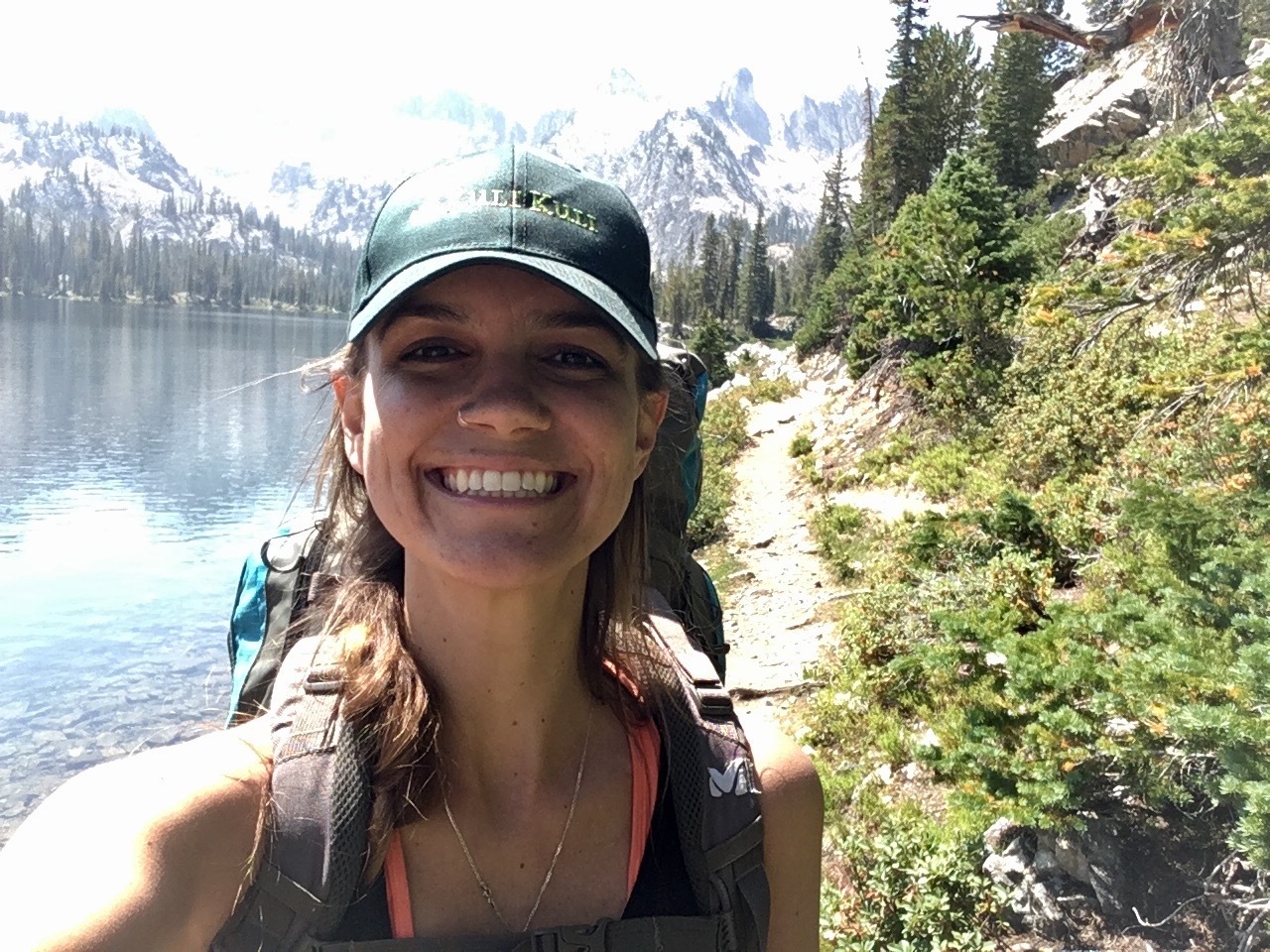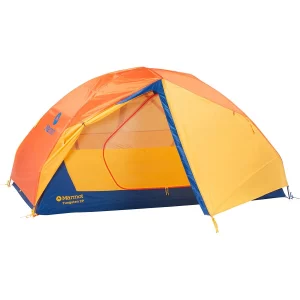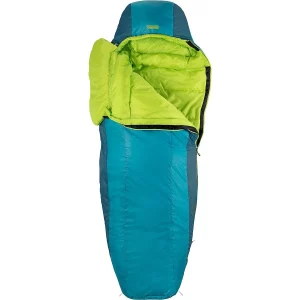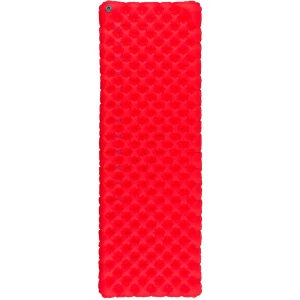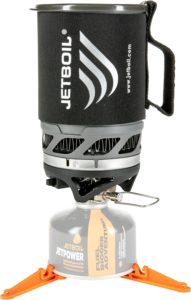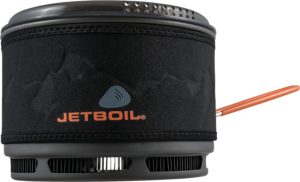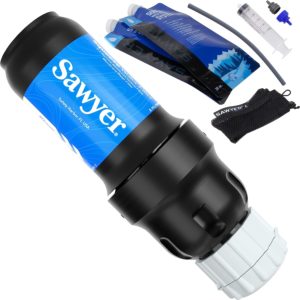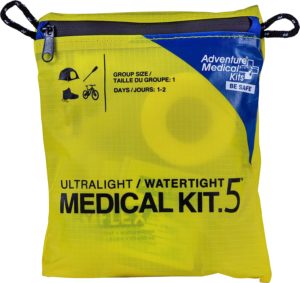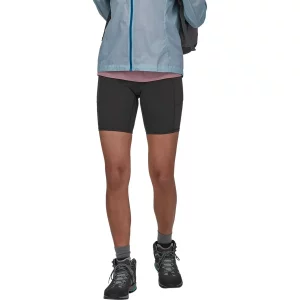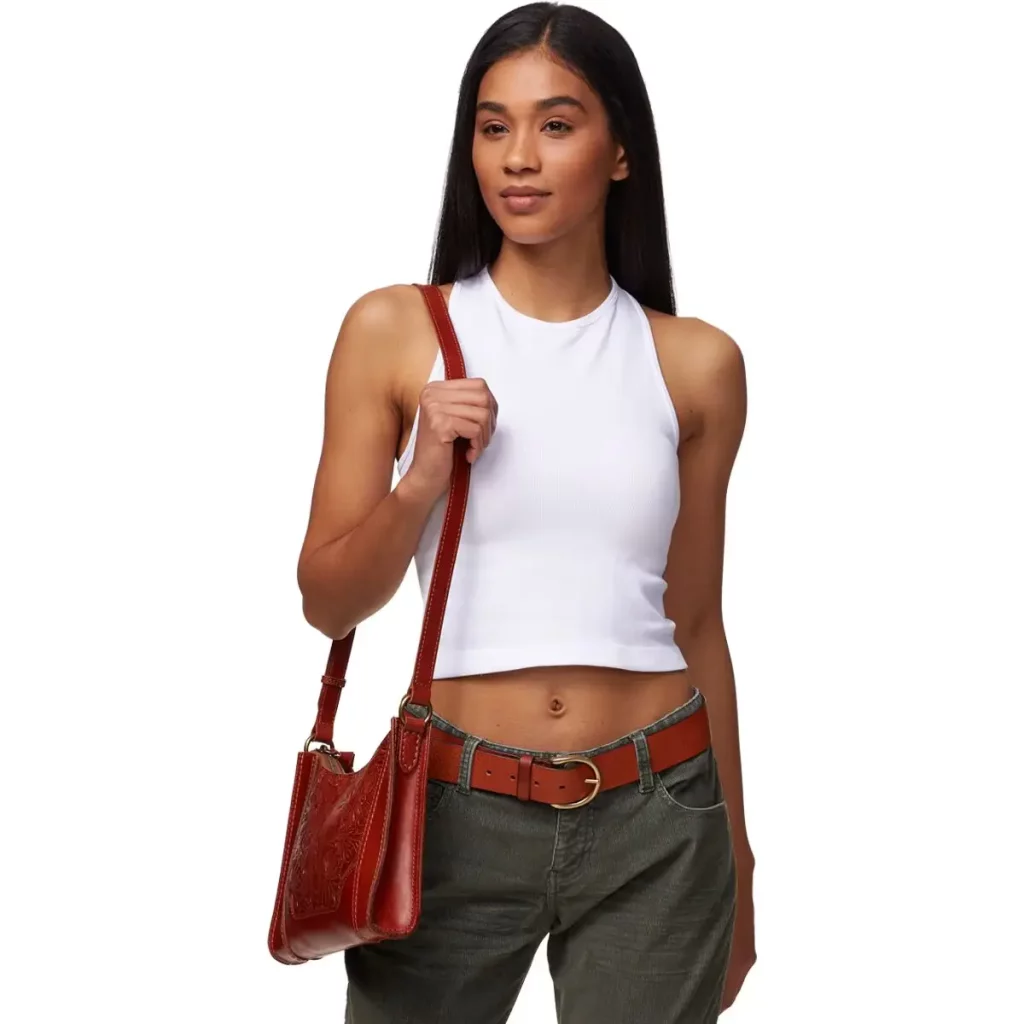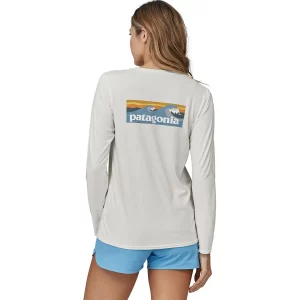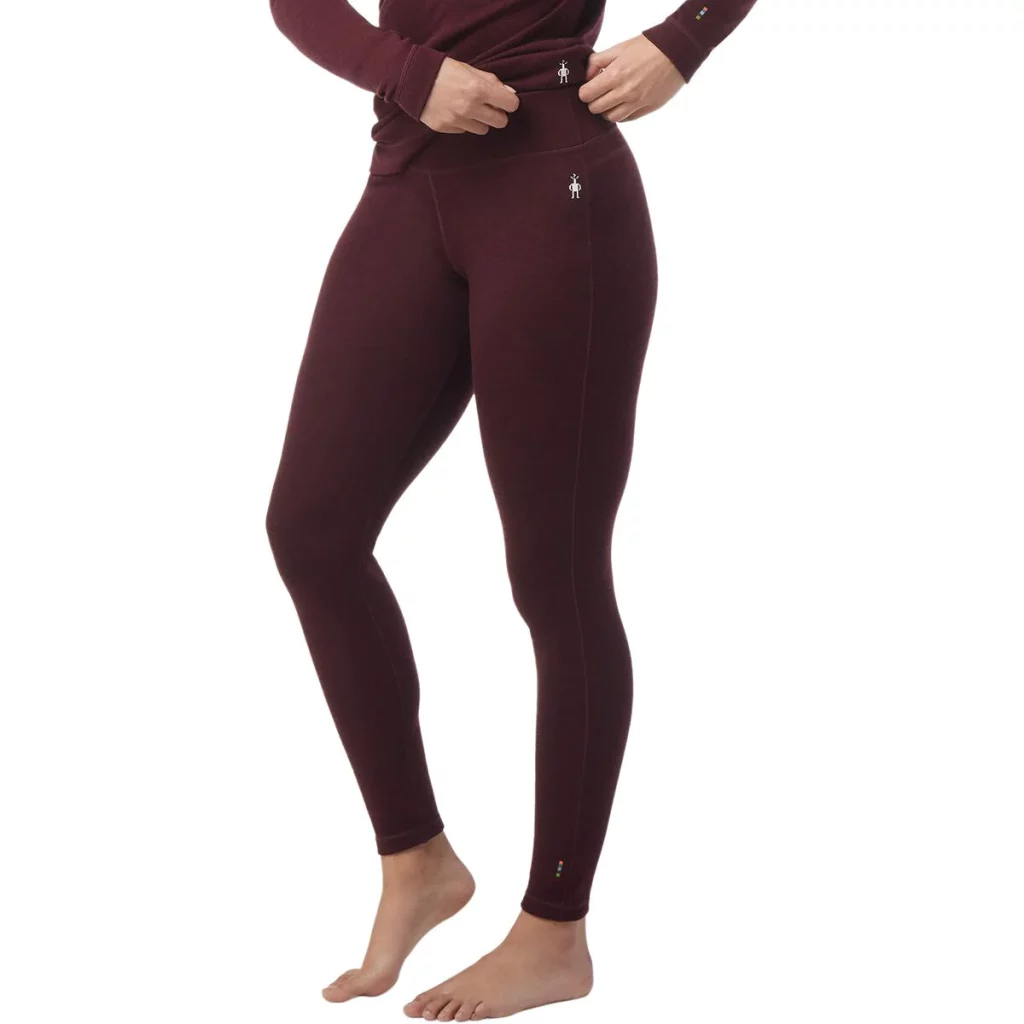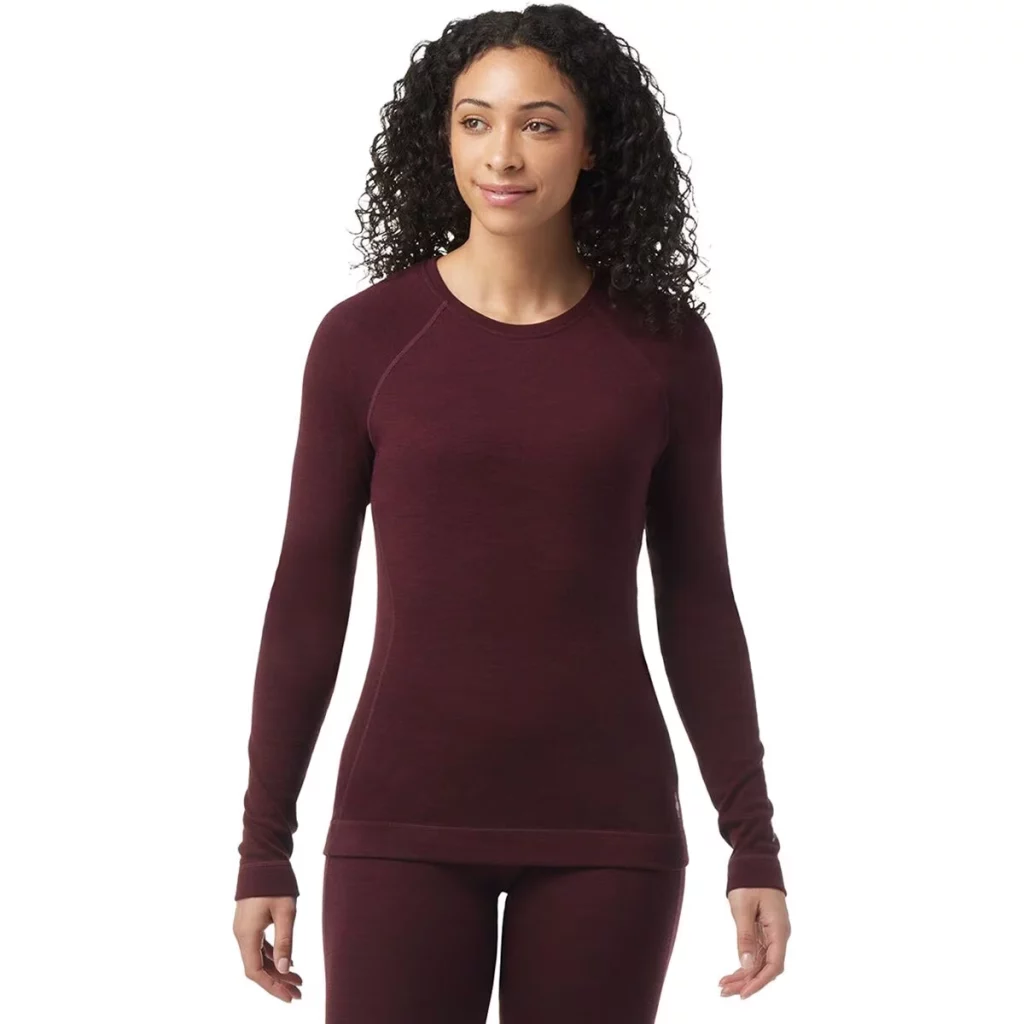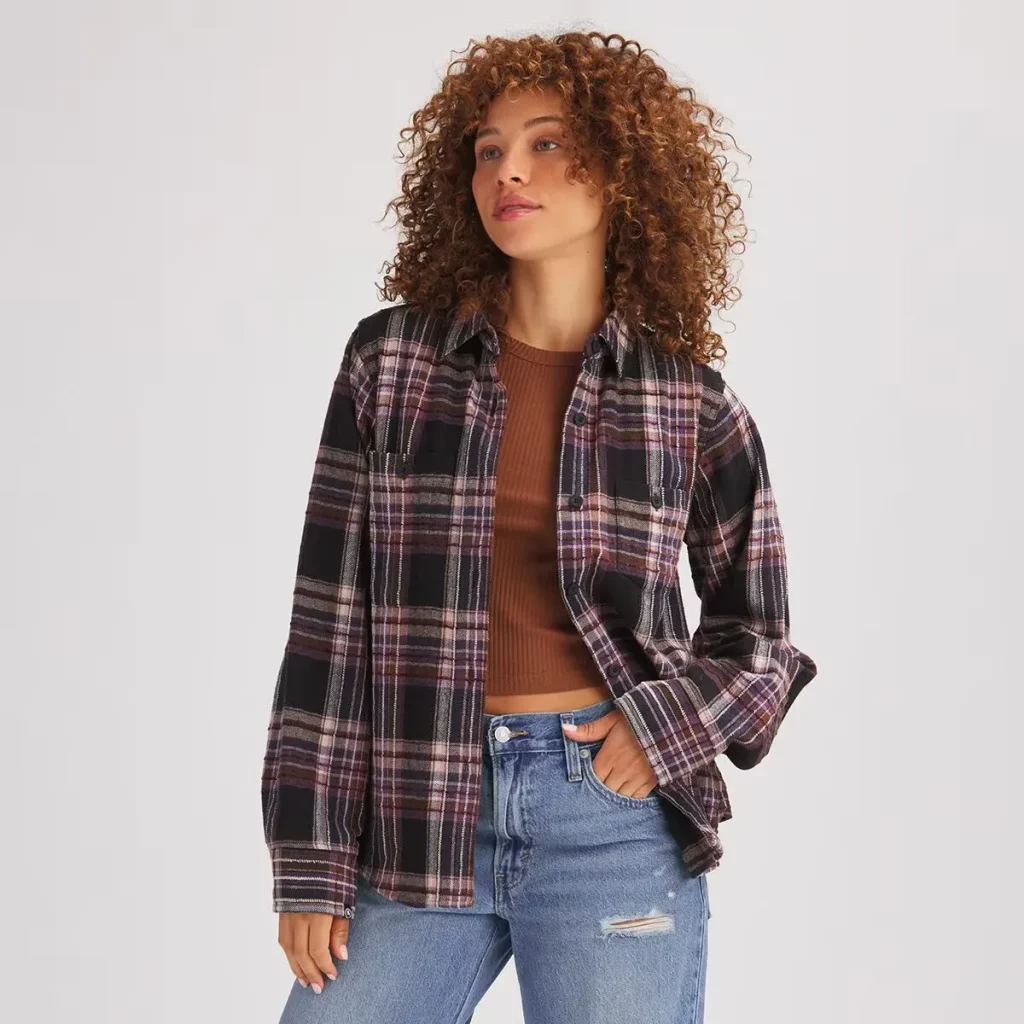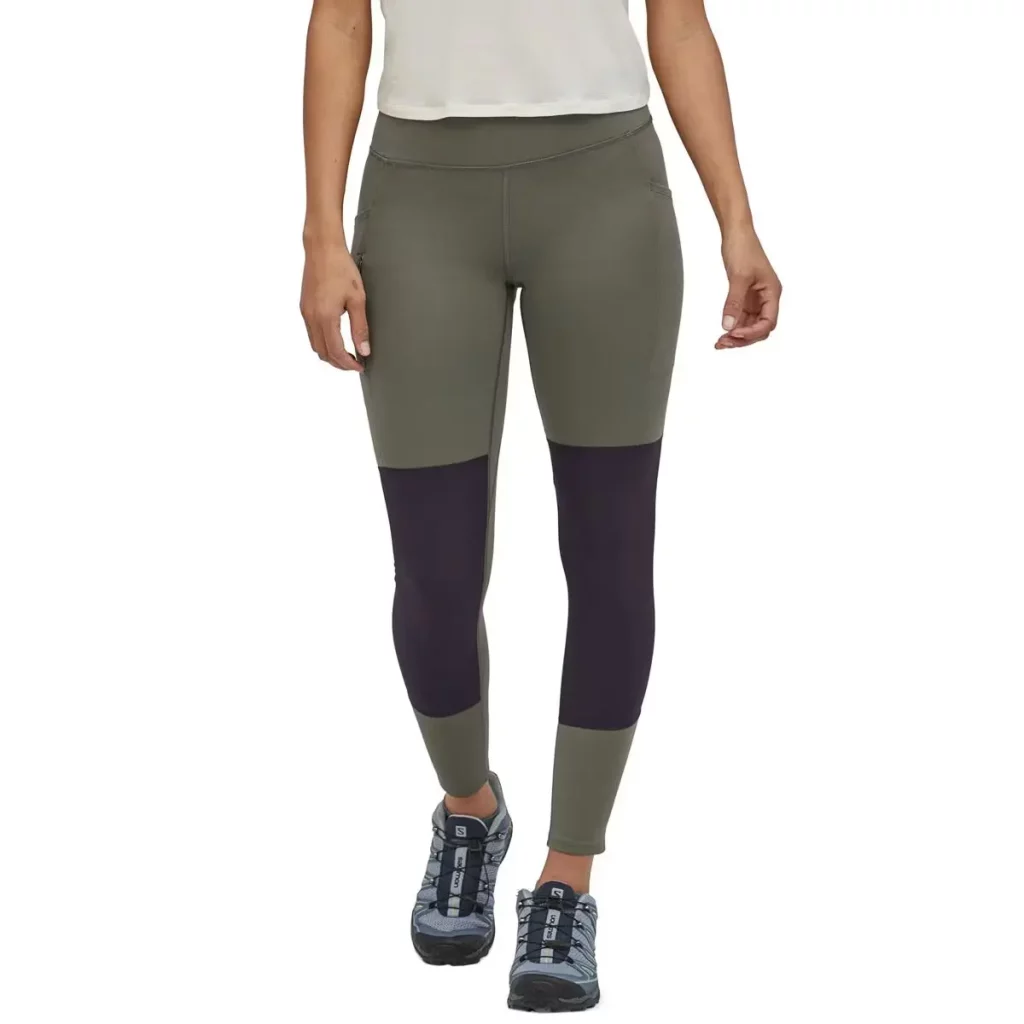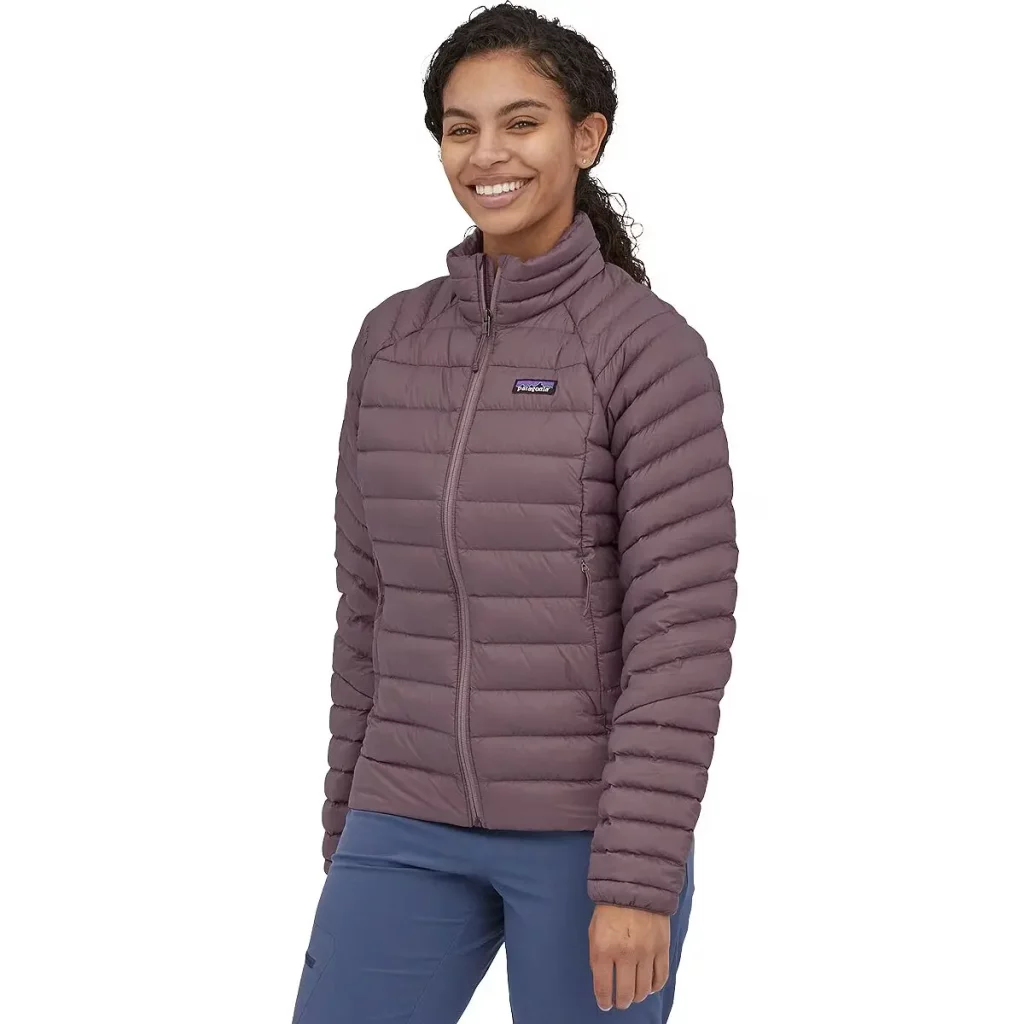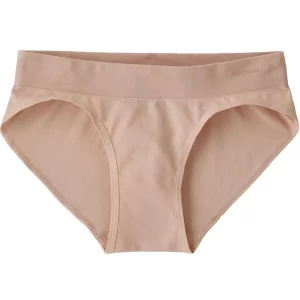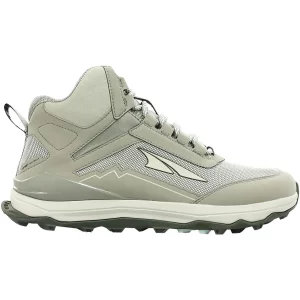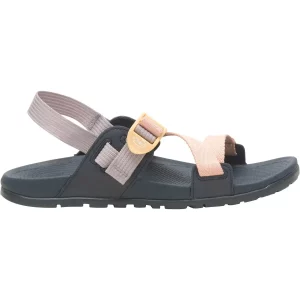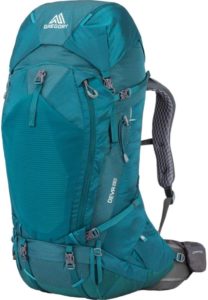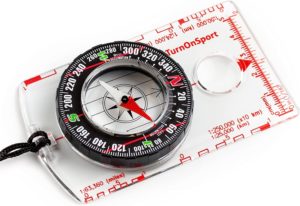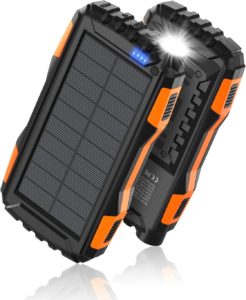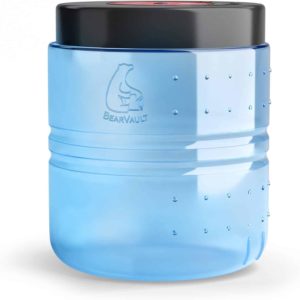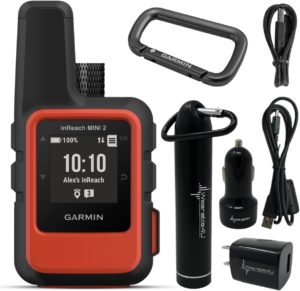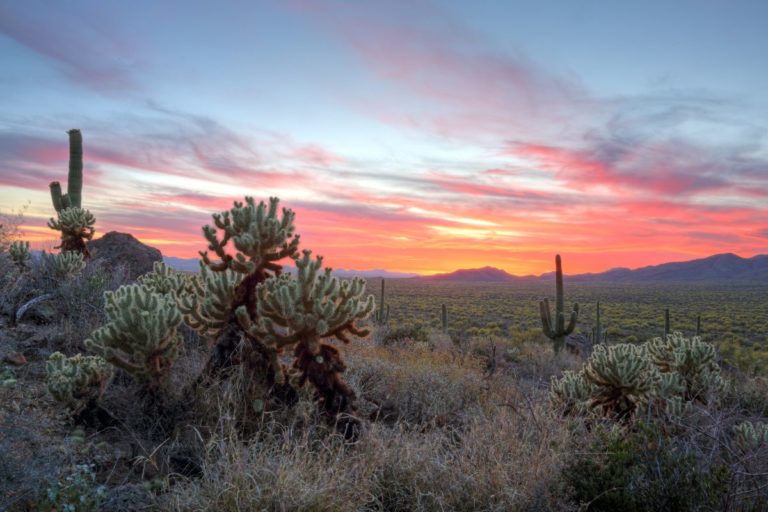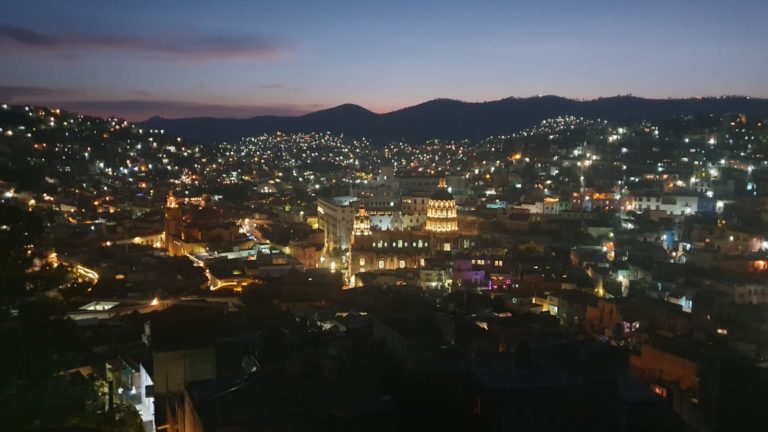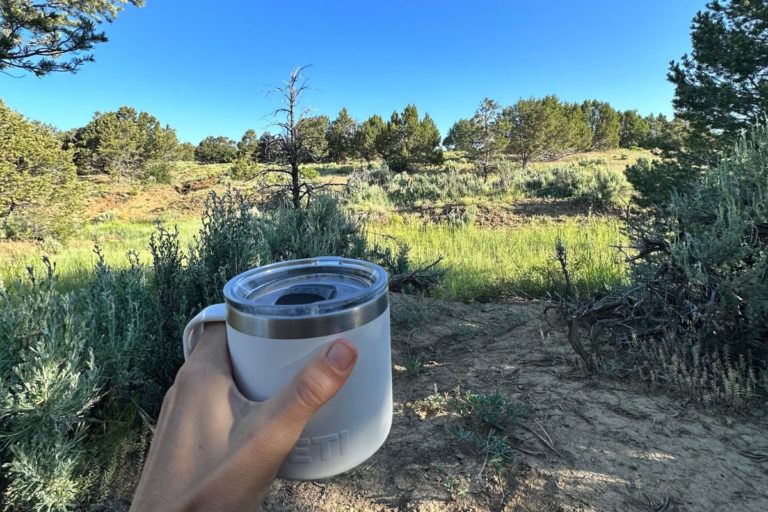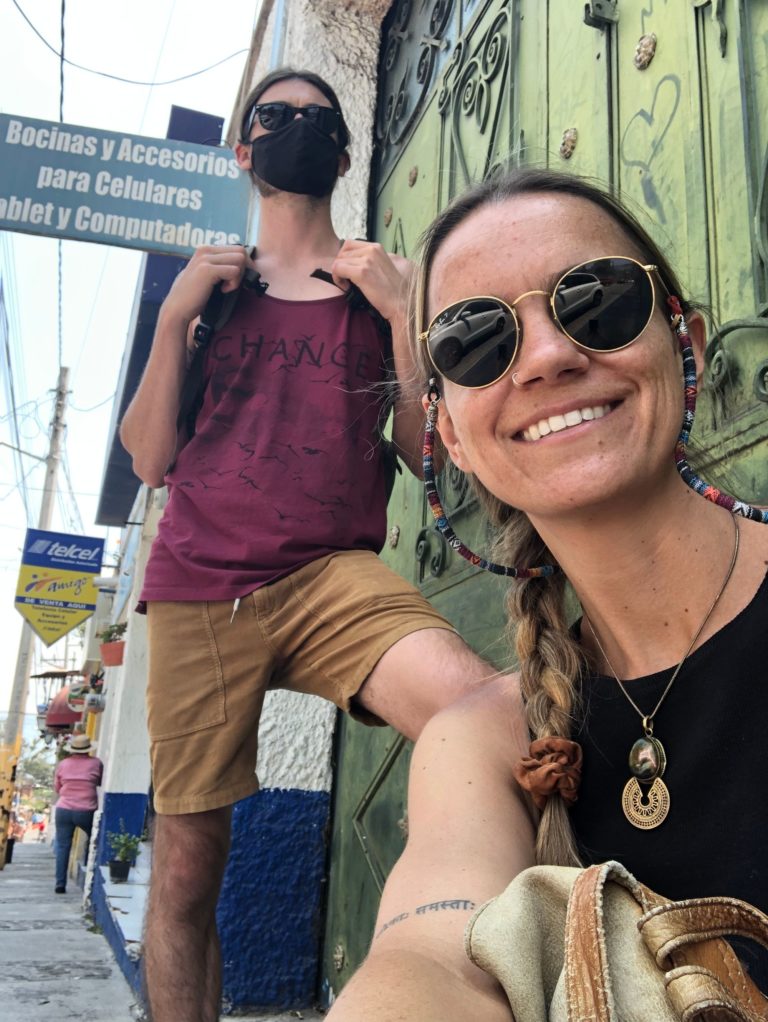Tips For Solo Camping From A Female Solo Camper
I’ve been camping solo all year and it has been fun. I backpacked through Central and South America 5-6 years ago and it was a similar experience of meeting new friends and discovering breathtaking beauty.
But now I’m doing it here in the US great outdoors, camping solo on my epic car camping trip. I’m meeting other solo campers, adapting to difficult situations, feeling confident in my own safety, having free time to do exactly what I want and where I want to…
…solo camping has been the best thing for my mental health and just life in general. So I’m stoked to help other campers find the same groove for themselves.
Most of my advice here will be based on car camping, either sleeping in your car like me or tent camping near your car. If you’re doing a backpacking trip, then prioritize lightweight gear.
Alright, let’s go through everything there is to know about going on a ✨solo camping trip✨!
✨ Is Camping Alone Safe?
Absolutely! But like anything in life, camping solo comes with its own set of challenges and precautions. Venturing into the wilderness solo can be an empowering and transformative experience, but it’s natural to have concerns about safety.
After all, the woods don’t come with streetlights, and the only sounds you might hear are the rustling of leaves or the distant hoot of an owl.
In this post, I’ll share solo camping tips and tricks so that you are well-prepared and confident on your solo camping journey.
✨ Solo Camping Checklist
Embarking on a solo camping journey requires meticulous preparation. Luckily, once you go on a few camping trips, it will become a smooth routine. You may already be familiar with some of these basic items, but just in case you’re not, I’ll include everything I pack with me here in this checklist.
My number one tip: only pack things you really need.
Here’s a detailed checklist to ensure you’re fully equipped for your first solo trip:
Tent and Tent Accessories
Read through my guide about how to stay warm in a tent to keep yourself warm while camping alone. A tent will often come with the tent itself, stakes and guylines, as well as a rainfly. A footprint or tarp can be purchased separately.
- Tent: Opt for a lightweight, easy-to-set-up tent. Consider a 1-2 person tent for ample space.
- Stakes and Guylines: Ensure they’re durable to withstand strong winds.
- Rainfly: Waterproof and covers the entire tent to protect against unexpected rain.
- Footprint: This goes under your tent to prevent wear and keep you dry.
Sleeping Gear
- Sleeping Bag: Choose one rated for the lowest temperature you expect.
- Sleeping Pad: An inflatable pad offers more comfort, while a foam pad provides durability.
Cooking Gear
- Cookware: A pot, pan, and utensils made of lightweight materials like titanium. I really like this messware kit for car camping, but a collapsible kit is better if you need to pack it anywhere.
- Biodegradable Soap: For cleaning without harming the environment.
- Bear Canister: Airtight and odor-proof. Remember to store it away from your campsite.
- Fuel: Canister or liquid fuel, depending on your stove type.
- Stove: A compact, lightweight stove like the Jetboil. If you have the space, the a two burner stove is great… even though I have that, I still use my Jetboil most often. I usually use my JetBoil cookware to prepare my meals:
Water and Filtration
- Water Bottles: At least two 1-liter bottles. I’m still a huge fan of Nalgene bottles. You can use them as hot water bottles if needed and the wide mouth makes it easy to refill with water filters.
- Water Filter: Something portable like the LifeStraw or a Sawyer Squeeze filter.
First Aid Kit
Customize it based on the trip length and potential risks. Include
- Tweezers, blister treatment, and a tick removal tool.
- Prescription medications and a list of emergency contacts.
I really like this kit, it’s lightweight and has a lot of the fundamentals:
Clothing
I have a pretty basic hiking outfit that I wear during the summer, then I build from there. I recommend doing the same… just find you absolute minimum clothing, your base layers, mid layers, and then extra warm outer layers if you neeeeeeeed it.
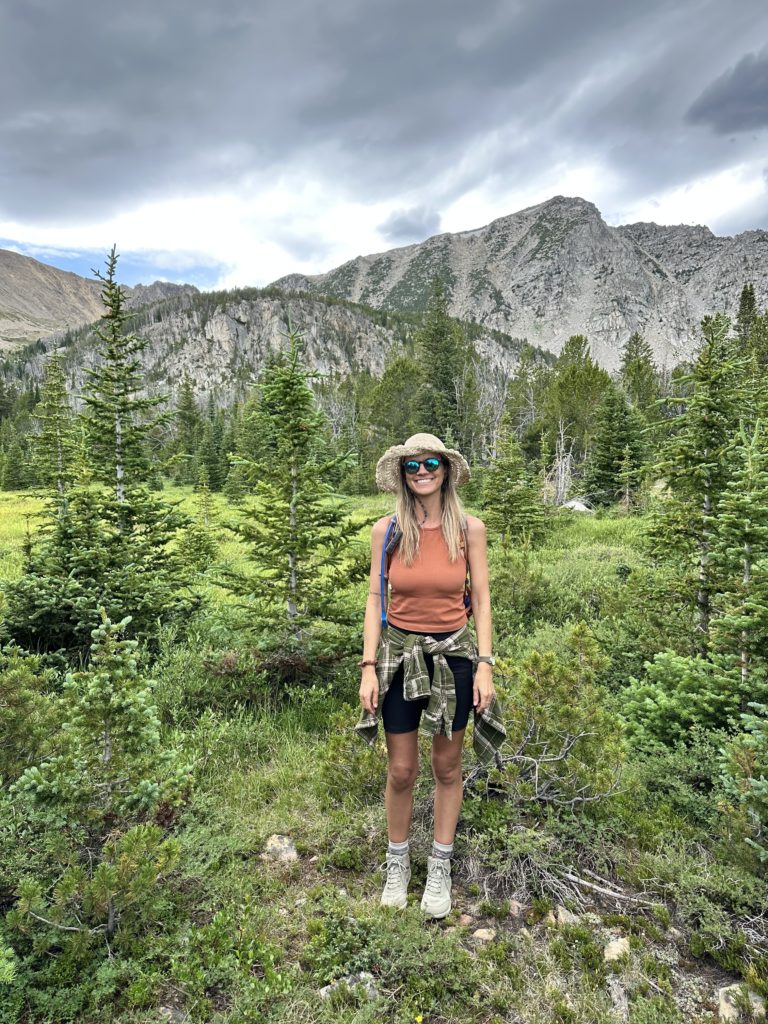
- Base Layers For Colder Weather: Synthetic or merino wool for moisture-wicking. This is especially important for sleeping, if you’re trying to stay warm.
- Mid-Layer: A fleece or down jacket. This is my mid-layer ‘fit for changing weather.
- Outer Layer: Waterproof and breathable rain jacket and pants.
- Undergarments: Quick-drying and moisture-wicking. I really like these Patagonia quick-drying panties:
Footwear
- Hiking Boots: Waterproof with good ankle support. These Altras are the besssssssssst. I have wide feet and these have a wide toe box and extra cushioning on the soles, which make it feel like you’re walking on clouds. They aren’t waterproof but are super breathable, making them easy to dry.
- Camp Shoes: Lightweight sandals or slip-ons. I LOVE my Chacos and this new style makes them less bulky on my wide feet.
Backpack
- Capacity: 50-70 liters for multi-day trips. Ensure it has adjustable straps and multiple compartments. This is what I use to store all of my camping gear. I just check it before heading out and make sure everything is where I think it is.
I really like this Deva backpack by Gregory, it is super comfortable and the storage is easily accessible from the front, top, or side.
Navigation Tools
I don’t actually use a map and compass when I’m out in the wilderness, but it’s important to always be prepared for the worst case scenario. This means we gotta bring some basic navigation tools in case we get stuck somewhere unreachable.
- Map: Waterproof and topographic. You’ll want to pick this up on your way out, if you’re headed into backcountry campsites.
- Compass: Learn basic orienteering skills.
- GPS: A device or a reliable app on your phone. I really like using AllTrails for staying on hiking trails. onX Backcountry is another really cool app to see backcountry trails and campsites.
Lighting
- Headlamp: Preferably with adjustable brightness and a red light mode.
- Lantern: Solar-powered or rechargeable ones are eco-friendly.
Personal Items
Take a look at my guide to camping essentials for women for an absolute breakdown of the kinds of personal items I recommend bringing along. Here’s generally what I recommend taking:
- Sunscreen: Broad-spectrum and water-resistant.
- Insect Repellent: DEET or a natural alternative.
- Toiletries: Toothbrush, toothpaste, and biodegradable toilet paper.
- Portable Douche: AKA travel bidet, this thing will keep you nice and fresh 😉
- Emergency Whistle: A high-pitched one that can be heard from a distance.
- Camp Chair: Look for one that’s collapsible and lightweight.
- Menstrual Products: Tampons, pads, or a menstrual cup (seriously, game changer).
- Biodegradable Wipes: For freshness.
- Bear Spray: If you’re in bear country, then always carry bear spray.
Entertainment
- Book: Perhaps a nature guide or a novel.
- Journal: Document your journey and thoughts.
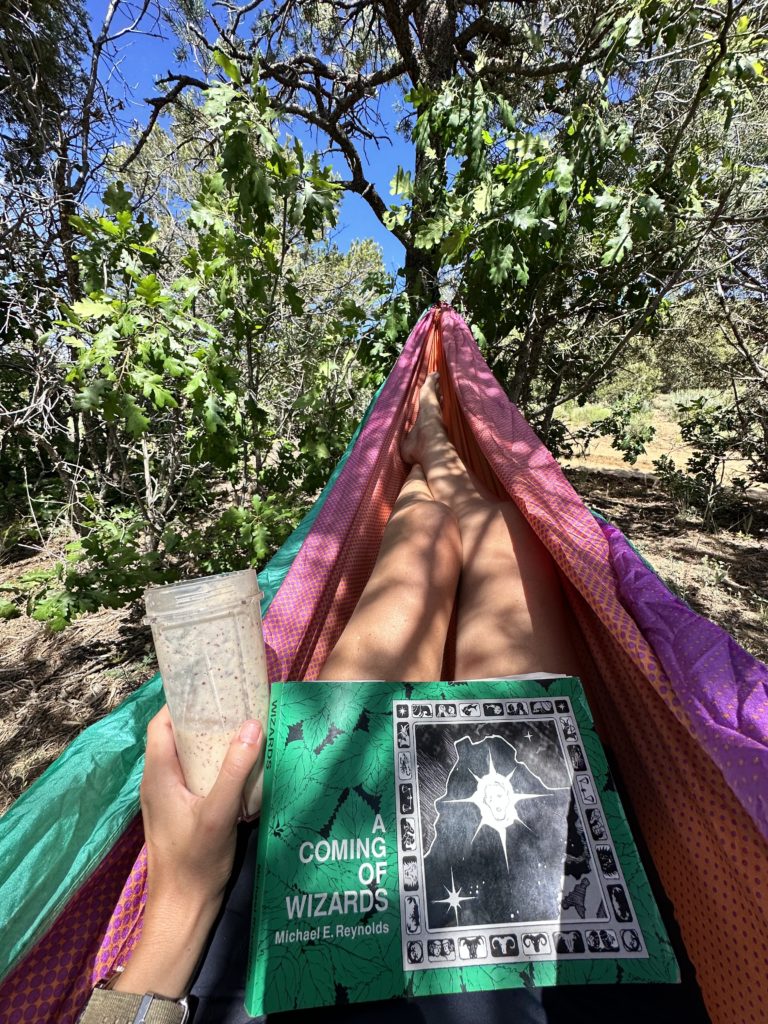
✨ What to Do Before You Go
Whether camping alone or with other campers, it’s helpful to be overly prepared each time. When it’s just you, it can be life or death. So take the time to thoroughly prepare for your solo camping trip.
Share Your Plans
Before you head out on your next solo trip or camping adventure, it’s pretty important to share your camping plans with someone.
This can be a family member, a close friend, or even a neighbor.
Sharing your plans ensures that someone is aware of your whereabouts and can raise an alarm if you don’t return as scheduled. It’s always better to be safe than sorry!
I’m on the Life360 app with my family and I always text the person I’m most in contact with nearby.
So right now, that’s my brother. 👉
That way if anything happens, someone local will know how to spring to action and be there within a few hours.
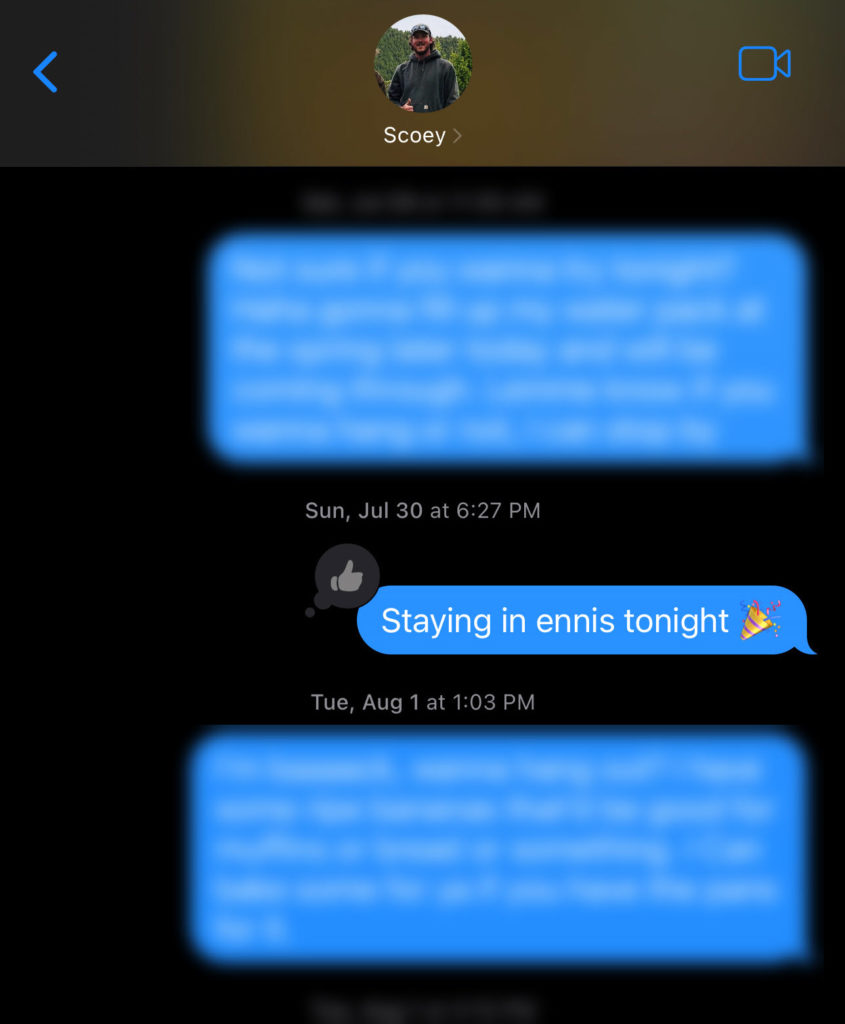
Know How to Use All Your Equipment
Before you go solo camping, make sure you’re familiar with every piece of equipment you’re bringing. Set up your tent in your backyard, test out your stove, and make sure you know how to use that fancy new water filter. I like to look up my specific product on YouTube and watch a few videos about it. This helps me become familiar with it or refresh my memory if it’s been awhile since I last used it.
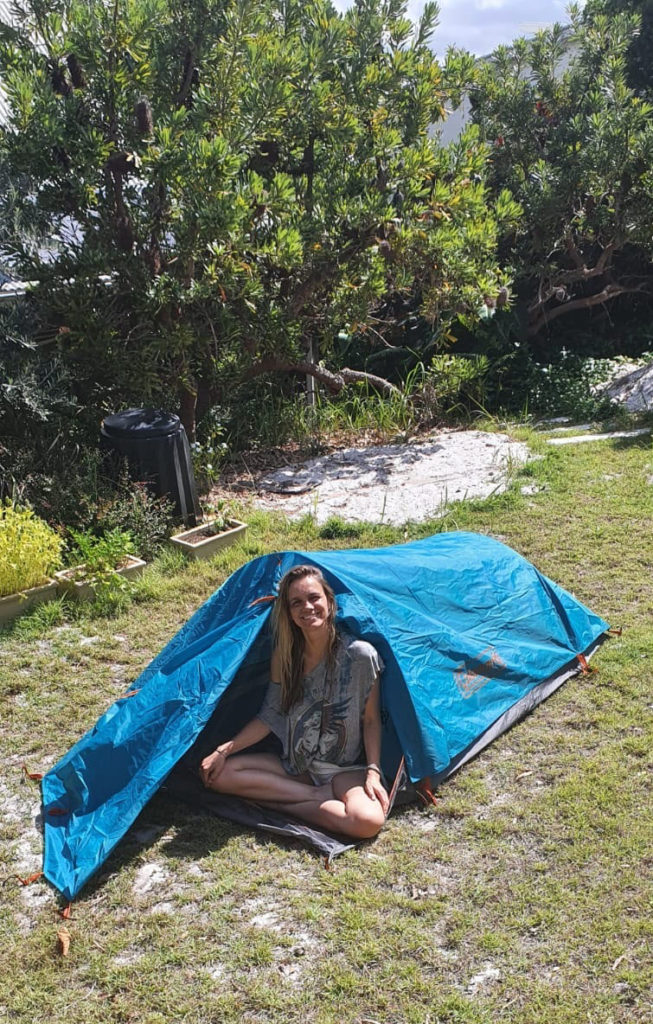
The last thing you want is to be fumbling around in the dark trying to figure things out.
Check the Weather Before You Leave
Mother Nature can be unpredictable, so always check the weather forecast for your camping destination. This will help you pack appropriately and be prepared for any sudden changes. Remember, it’s not just about checking if it’ll rain or shine; also look out for temperature drops, wind speeds, and any potential storms.
I like to use Storm Radar so that I can see what kinds of clouds are forming. I also pack in layers, preparing for both scorching heat and a hail storm.
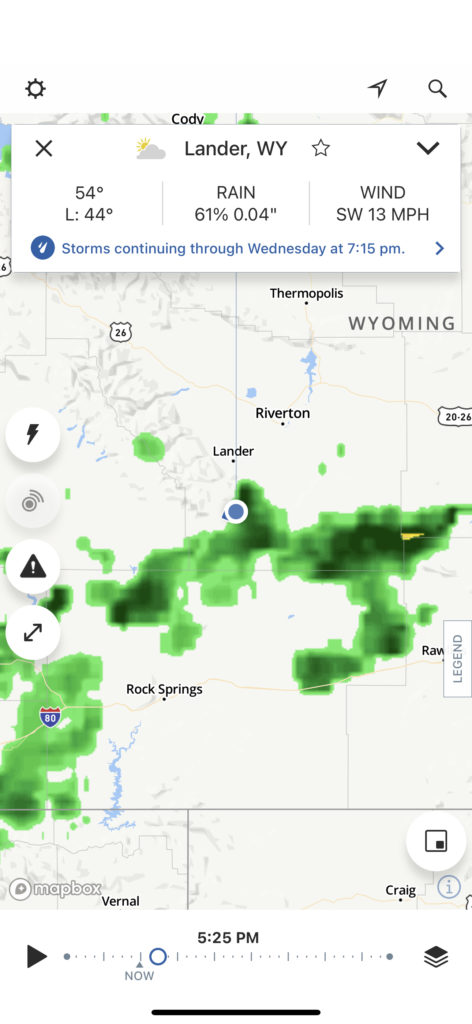
Do a Gear Check Before You Go
You’ve got your list of camping essentials, but have you double-checked everything? Ensure all your gear is in good condition and that you haven’t forgotten anything. From your trusty sleeping bag to that essential camping lantern, make sure everything is packed and ready to go. Check the batteries on everything and that you didn’t accidentally leave something nasty in there from your last trip.
Charge Your Devices
While the idea of camping is to disconnect, it’s essential to have a charged phone or GPS device, especially when you’re on your own. Charge all your devices fully before you leave and consider bringing a portable charger or solar panel. This way, you can call for help if needed or simply check in with loved ones to let them know you’re okay.
Arrive at Your Campsite Early
Getting to your campsite early gives you ample time to set up, familiarize yourself with the area, and settle in before it gets dark. It’s much easier to pitch a tent and organize your campsite in daylight. Plus, arriving early allows you to pick the best spot, ensuring you have a comfortable and safe night ahead.
PRO TIP: Most campsites empty out on Tuesdays and start filling up on Thursdays.
How to Choose a Campsite When Camping Alone
It’s not just about snagging a spot with the best sunrise view (though that’s a bonus); it’s about feeling safe, ensuring you can easily get there, and having those little comforts that make the experience even better.
Safety First: I can’t stress this enough – when I’m out camping alone, my safety is always top of mind. And a golden rule I always follow: always let a friend or family member know where I’m headed and when I plan to be back.
Accessibility: I’m all about that easy access. Whether I’m setting up right next to my car (shoutout to my Car Camping adventures) or trekking a short distance with my gear, I make sure the site is reachable without too much hassle. Being close to my vehicle isn’t just convenient; it’s a safety net if I need to make a quick exit.
Amenities: Now, I’m all for roughing it, but a girl likes her comforts too. Depending on my mood and the trip, I might opt for a campsite with a few added perks. Some spots I’ve been to offer basics like pit toilets or fire pits, while others go all out with showers and picnic tables. It’s all about what vibes with my camping mood.
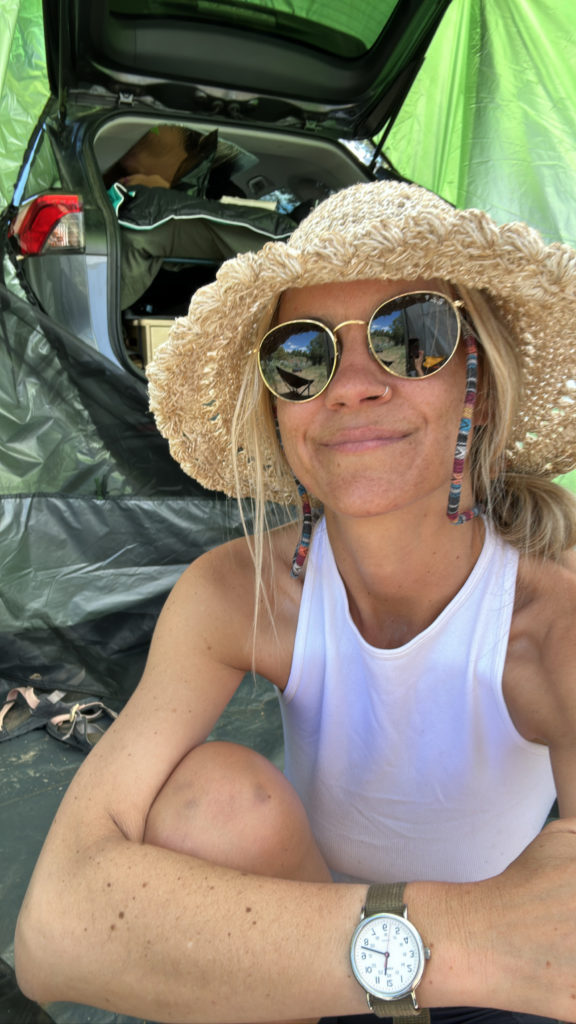
Research is Key: Before I hit the road, I always do my homework. There are some fantastic platforms out there to scout the best spots. My favorite is The Dyrt.
And, as I’ve mentioned in my Car Camping Tips post, diving into reviews from fellow campers is a treasure trove of insights. They’ve been there, done that, and their experiences can guide your choices.
✨ Tips for Camping Alone
The most important thing when camping alone is prioritizing safety. Safety against the elements, wildlife, your clumsy gorgeous self, and those creepy dangerous people that ruin everything. I’ve been hiking alone as a woman all summer long and a lot of my safety tips for solo hiking are very similar to those for solo camping.
Know Your Abilities
While it’s tempting to push your limits, remember that when you’re alone, you’re the only one responsible for your safety. Whether it’s choosing a hiking trail, setting up camp, or deciding how far to travel in a day, always err on the side of caution. It’s better to have a relaxed and enjoyable experience than to overextend yourself and risk injury or exhaustion. Solo camping is about connecting with nature and yourself, not proving anything. So, take it easy, enjoy the journey, and always prioritize your safety.
Be Prepared
Carry essential safety gear like a first aid kit, flashlight, and a whistle. If you’re camping in bear country, secure your food to avoid attracting wildlife. Also, carry bear spray to be prepared for that.
Be Bear And Wildlife Safe
When camping, especially in bear country, it’s crucial to store food securely. Always secure your food, either in your car or a bear-resistant food storage container, to prevent attracting animals to your campsite. A food bag hanging system can be an effective solution for this. Some campsites will have bear lockers. Remember, the goal is not just to protect yourself but also to ensure that wildlife doesn’t become accustomed to human food, which can be dangerous for them and future campers.
Trust Your Instincts
Your gut feeling is your best guide. If a location or situation doesn’t feel right, trust your instincts and move on. The beauty of solo camping is the flexibility it offers – if a place doesn’t feel safe, you can always relocate. Avoid wandering around unfamiliar areas at night and always be conscious of your surroundings.
Carry A Satellite Emergency Device
In remote areas, cell service can be spotty or non-existent. A satellite emergency device can be a lifesaver, allowing you to send distress signals or communicate with emergency services even when you’re off the grid.
Stay Connected
While the idea of disconnecting might be appealing, it’s essential to have a way to communicate in case of emergencies. Share your location with a trusted friend or family member. Consider having a reliable internet connection, especially if you’re camping in remote areas. Check out these tips on how to get Wi-Fi while camping.
Lock Up
Always lock your car doors when you’re inside, especially if you’re car camping. This simple step can provide an added layer of security and peace of mind. If you’re camping in bear country, locking your doors can also prevent curious wildlife from accidentally opening your vehicle.
Always Have A Backup Plan
Things don’t always go as planned. Whether it’s an unexpected change in weather or an uncomfortable vibe at a campsite, always have a backup plan.
Follow Leave No Trace Principles
These seven guidelines are our roadmap to enjoying nature without harming it. Here’s a quick rundown:
- Plan Ahead and Prepare: Before you head out, know the regulations and potential hazards of your camping spot.
- Travel and Camp on Durable Surfaces: Stick to established trails and campsites. Avoid trampling on delicate terrains.
- Dispose of Waste Properly: Pack it in, pack it out. All your trash, leftover food, and litter should come back with you.
- Leave What You Find: Those pretty rocks and plants? Leave them be. Preserve the environment for others to enjoy.
- Minimize Campfire Impact: Use a camp stove for cooking. If you must make a fire, keep it small and burn only small sticks.
- Respect Wildlife: Observe animals from a distance. Never feed them or approach them.
- Be Considerate of Other Visitors: Keep the noise down and yield the trail to others.
It’s all about enjoying the wild responsibly. Let’s make sure our beautiful great outdoors stays that way for generations to come! 🌎💚
Meal Prep & Storage Tips for Camping
Preparing and storing your food efficiently can make a world of difference, turning potential mealtime hassles into smooth, enjoyable feasts. By investing a little time in pre-trip meal prep and following some simple storage guidelines, you can ensure that your food remains fresh, tasty, and ready-to-eat, allowing you more time to soak in the beauty of nature.
- Pre-Portion Meals: Before heading out, divide your meals into individual portions. This not only saves space but also reduces cooking time at the campsite.
- Use Reusable Containers: Opt for airtight, reusable containers or zip-lock bags. They’re perfect for storing pre-chopped veggies, sauces, and other ingredients.
- Freeze Ahead: For longer trips, consider freezing meals ahead of time. They’ll act as additional ice packs for your cooler and thaw gradually.
- Keep Dry Foods Separate: Store dry foods like rice, pasta, and granola in separate containers to prevent them from getting soggy.
- Prioritize Perishables: Plan to eat perishable foods like fresh produce earlier in your trip, saving non-perishables for later days.
- Maintain Cooler Etiquette: Always keep your cooler in a shaded area and limit its opening. Use block ice for longer-lasting coolness and layer items based on when you’ll eat them.
- Avoid Raw Meats: If possible, avoid taking raw meats. Instead, consider pre-cooking or opting for plant-based protein sources to reduce the risk of spoilage.
- Stay Organized: Label your containers and keep a meal plan handy. Knowing where everything is and what’s for dinner each night makes things easier.
- Pack a Mini Spice Kit: A small container with essential spices can elevate your meals. Think salt, pepper, chili flakes, and your favorite seasoning blends.
- Remember Food Safety: Always keep hot foods hot and cold foods cold. If in doubt about the freshness of an item, it’s better to be safe and skip it.
With these tips in hand, you’re all set to enjoy delicious and hassle-free meals during your next solo trip or camping adventure.
✨ Solo Camping Activities
Solo camping is an opportunity to truly connect with nature, find inner peace, and indulge in activities that you love.
Seriously, it’s the most healing thing that I can do for myself and it’s because I learn to sit with myself and enjoy my own company.
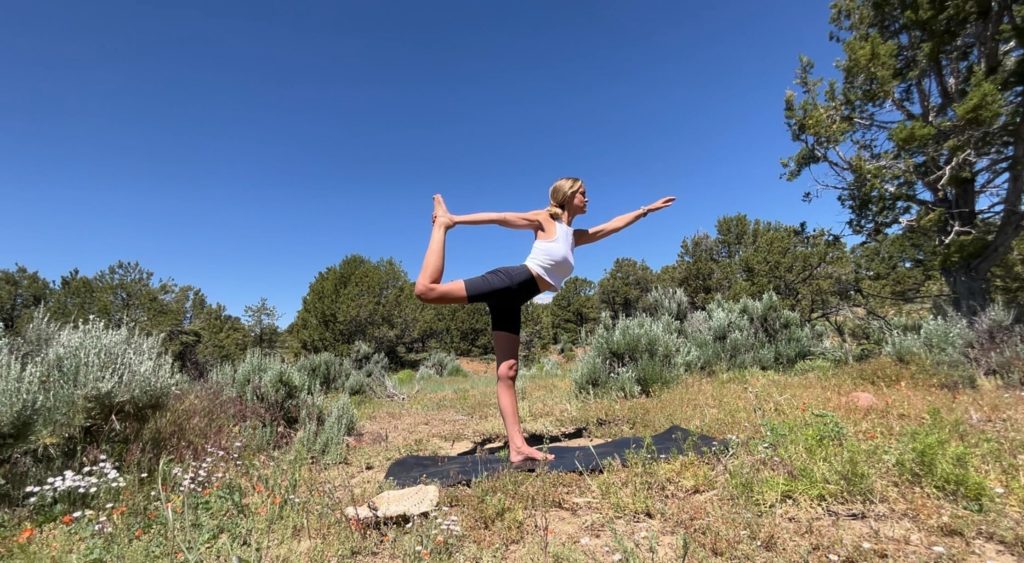
Here are some solo camping activities I love to do while camping alone:
- Nature Journaling: Bring along a journal and jot down your observations, feelings, and sketches of the natural world around you. It’s a therapeutic way to connect with your surroundings.
- Photography: Capture the beauty of the wilderness. Whether it’s the golden hour, wildlife, or the intricate patterns of leaves, there’s always a picture waiting to be taken.
- Forest Bathing: Forest bathing, or “shinrin-yoku” as it’s traditionally known in Japan, is a practice about immersing oneself in the serene ambiance of a forest, allowing the natural surroundings to cleanse the mind and spirit, promoting a profound sense of well-being and connection to nature.
- Stargazing: Without the light pollution of the city, the stars in the wilderness shine brighter. Lay back and gaze up, maybe even spot a shooting star or two.
- Meditation and Yoga: The tranquility of nature provides the perfect backdrop for meditation and yoga. Find a serene spot, lay out your mat, and find your zen. You can give my travel yoga sequence a try!
- Reading: Bring along that book you’ve been meaning to read. The sound of nature can be the perfect background noise for diving into a good story.
- Cooking: Experiment with campfire recipes.
- Hiking: Explore the trails and go on a day hike. Remember to always let someone know where you’re going and when you expect to be back, especially when hiking alone.
- Crafting: Whether it’s knitting, drawing, or any other craft, the peaceful environment can boost your creativity.
- Enjoying the Solitude: Sometimes, doing nothing and just being present in the moment, listening to the sounds of nature, and soaking in the surroundings is the best activity.
- Campfire Stories: Who says you need a group to enjoy campfire stories? Narrate your own tales or revisit some old favorites.
Solo camping is all about enjoying your own company and doing things at your own pace. It’s a time to reflect, rejuvenate, and reconnect with nature.
✨ Vegan Solo Camping Meals
These meals aren’t really that backpacker friendly because they are generally pretty heavy for carrying. But these are some of my favorite solo camping meals when I’ve got a car camping site.
Check out my epic list of vegan road trip snacks for more ideas and inspiration 🤤
1. Fresh Fruit & Granola Bowl
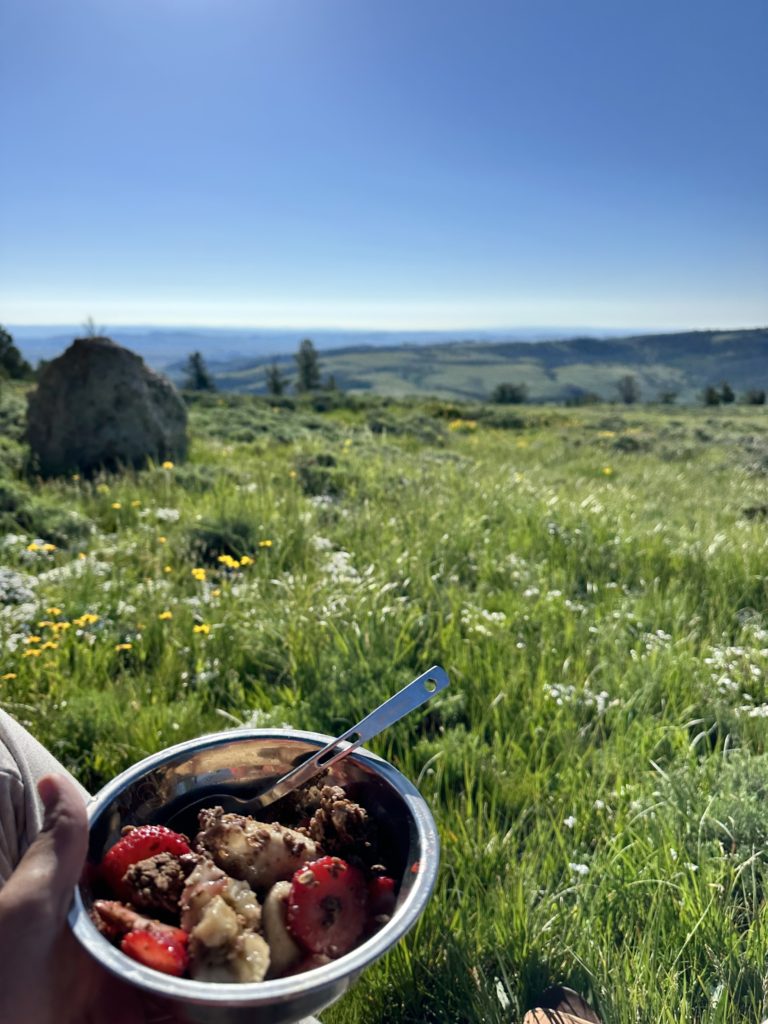
This bowl is a refreshing way to kickstart your morning in the great outdoors. The combination of fresh fruits provides essential vitamins and energy, while granola adds a satisfying crunch. For backpacking, pre-pack granola in a zip-lock bag and carry lightweight, durable fruits like apples or dried fruits. For car camping, store fruits in a cooler and keep almond milk or coconut yogurt chilled until use.
- Ingredients: Fresh seasonal fruits (like berries, banana slices, and kiwi), granola, almond milk or coconut yogurt.
- Preparation: Layer the fruits in a bowl, sprinkle granola on top, and add a splash of almond milk or a dollop of coconut yogurt.
2. Vegan Tofu Omelet
A protein-packed breakfast option, this omelet is both filling and nutritious. The tofu provides essential amino acids, while veggies add flavor and fiber. When backpacking, carry firm tofu in its original packaging and consume it early in the trip. For car camping, store in a cooler to maintain freshness.
I also eat eggs pretty regularly because they last longer and also I just like them better. So, you know, do you boo. That’s the whole point of a solo camping trip!
- Ingredients: Firm tofu, turmeric, black salt (for an eggy flavor), nutritional yeast, diced bell peppers, onions, spinach, and vegan cheese.
- Preparation: Blend tofu with spices until smooth. Pour onto a heated non-stick pan, add veggies, and cook until set. Fold and serve.
3. Green Power Smoothie
This smoothie is a nutrient-dense option, perfect for a quick energy boost. Dried spinach and kale offer iron and vitamins, while banana provides natural sweetness.
- Ingredients: Dried green powder, banana, almond milk, chia seeds, and a touch of agave nectar.
- Preparation: Blend all ingredients until smooth.
4. Vegan BLT Sandwich
A classic with a vegan twist, this sandwich offers a balance of textures and flavors. Vegan bacon strips add smokiness, while fresh veggies provide crunch. For both backpacking and car camping, store ingredients separately and assemble when ready to eat to prevent sogginess.
- Ingredients: Vegan bacon strips, lettuce, tomato, vegan mayo, and whole grain bread.
- Preparation: Layer the ingredients between slices of bread.
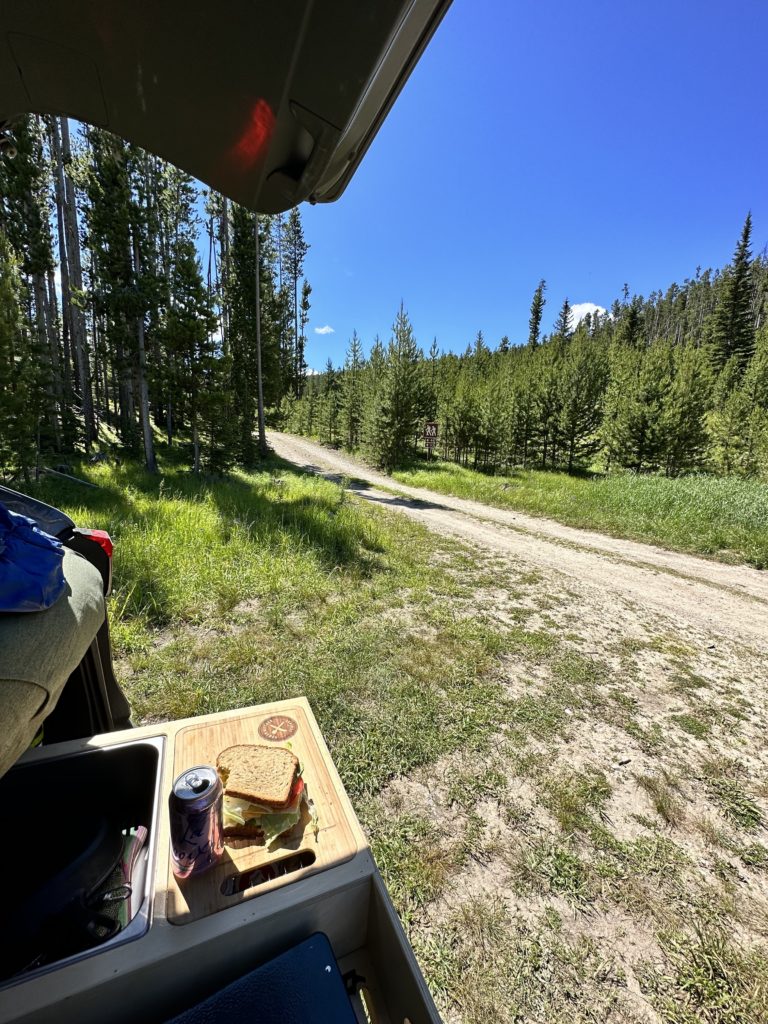
5. Chickpea “Tuna” Sandwich
A hearty and protein-rich sandwich, chickpeas mimic the texture of tuna, making it a vegan favorite. For backpacking, carry canned chickpeas and mix ingredients on-site. For car camping, pre-make the mixture and store in a cooler.
- Ingredients: Mashed chickpeas, vegan mayo, diced celery, diced pickles, lemon juice, salt, pepper, and bread.
- Preparation: Mix ingredients in a bowl and spread between bread slices.
6. Vegan Pesto & Avocado Sandwich
This sandwich is a creamy delight, with healthy fats from avocado and a burst of flavor from pesto. Store ingredients separately and assemble on-site to maintain freshness, regardless of your camping method.
- Ingredients: Vegan pesto, sliced avocado, arugula, and ciabatta bread.
- Preparation: Spread pesto on bread, layer with avocado slices and arugula.
7. Thai Coconut Curry Bowl
A warm and comforting dish, this curry bowl is perfect for chilly nights. For backpacking, consider dehydrated coconut milk and pre-cooked rice. For car camping, store coconut milk in a cooler and cook fresh rice on a portable stove.
- Ingredients: Coconut milk, red curry paste, tofu cubes, bell peppers, broccoli, and jasmine rice.
- Preparation: Sauté veggies and tofu, add curry paste and coconut milk. Simmer and serve over rice.
8. Quinoa Buddha Bowl
A balanced meal in a bowl, this dish offers protein, healthy fats, and veggies. For backpacking, carry cooked quinoa and canned chickpeas if you don’t mind the weight. For car camping, pre-cook ingredients and store in a cooler, assembling on-site.
- Ingredients: Cooked quinoa, roasted chickpeas, avocado slices, steamed broccoli, cherry tomatoes, and tahini dressing.
- Preparation: Arrange ingredients in a bowl and drizzle with dressing.
9. Vegan Taco Bowl
A fiesta in a bowl, this dish is both flavorful and filling. For both camping methods, store ingredients separately and heat the vegan meat crumbles before serving.
- Ingredients: Vegan meat crumbles, black beans, corn, lettuce, pico de gallo, avocado, and lime rice.
- Preparation: Layer ingredients in a bowl and top with your favorite vegan sauce.
10. Avocado Pasta
A creamy and satisfying dish, the avocado acts as a healthy alternative to traditional sauces. For backpacking, carry pasta and a ripe avocado. For car camping, store avocados in a cool place and cook pasta fresh.
- Ingredients: Cooked pasta, ripe avocado, lemon juice, garlic, olive oil, and cherry tomatoes.
- Preparation: Blend avocado with garlic, lemon juice, and olive oil. Mix with pasta and top with cherry tomatoes.
11. Vegan BBQ Jackfruit Sandwich
A tangy and meaty-textured sandwich, jackfruit is a vegan favorite. For both camping methods, store canned jackfruit and BBQ sauce separately, heating before assembling.
- Ingredients: Canned jackfruit, BBQ sauce, coleslaw, and buns.
- Preparation: Sauté jackfruit with BBQ sauce and serve on buns with coleslaw.
12. Vegan Caesar Salad
A light and crunchy option, this salad is perfect for lunch. For backpacking, carry vegan dressing in a small container. For car camping, store lettuce in a cooler to maintain crispness.
- Ingredients: Romaine lettuce, vegan Caesar dressing, vegan parmesan, and croutons.
- Preparation: Toss ingredients in a bowl.
13. Vegan Lentil Soup
A warm and hearty soup, lentils provide protein and fiber. For backpacking, consider pre-cooked lentils. For car camping, cook fresh on a portable stove, storing ingredients in a cooler.
- Ingredients: Lentils, diced tomatoes, carrots, celery, onions, garlic, vegetable broth, and spices.
- Preparation: Sauté veggies, add lentils and broth. Simmer until lentils are tender.
14. Vegan Stuffed Bell Peppers
A wholesome and filling dish, these peppers are both tasty and nutritious. For backpacking, carry pre-mixed quinoa filling. For car camping, store bell peppers in a cooler and cook fresh.
- Ingredients: Bell peppers, quinoa, black beans, corn, diced tomatoes, and vegan cheese.
- Preparation: Mix quinoa with beans, corn, and tomatoes. Stuff peppers and bake until tender.
15. Vegan Mushroom Stroganoff
A creamy and rich pasta dish, this stroganoff is perfect for dinner. For both camping methods, store ingredients separately, cooking fresh mushrooms and pasta on-site.
- Ingredients: Mushrooms, onions, garlic, vegan sour cream, vegetable broth, and pasta.
- Preparation: Sauté mushrooms and onions, add broth and sour cream. Serve over pasta.
These recipes are designed to be simple and quick, perfect for your solo trips and camping. You can prep some of the ingredients at home to make the cooking process even smoother at the campsite.
✨ Solo Camping FAQ
Here are some quick and dirty questions about camping alone.
Is Camping Alone Fun?
Absolutely! From waking up to stunning sunrises to cooking meals in the wilderness, a solo camping trip is filled with memorable moments. Plus, you get to choose your activities without compromising. That being said, it’s not for everyone. Try stepping out of your comfort zone a little bit and see how you like it 🙂
Is It Weird To Go Solo Camping?
Absolutely not! Solo camping is a unique experience that allows you to connect with nature on a personal level. It’s a chance to reflect, recharge, and challenge yourself. Plus, you get to set your own pace and itinerary.
What If I’m A Little Scared?
Start by doing thorough research and planning. Familiarize yourself with the camping location and its surroundings. Share your plans with a trusted friend or family member. And always trust your instincts—if a place doesn’t feel right, move on. Remember, the beauty of car camping is the flexibility to drive away if needed.
Why Do People Want To Solo Camp?
Solo camping offers a sense of freedom and independence. It’s an opportunity to disconnect from the daily grind, immerse yourself in nature, and gain a deeper understanding of yourself. Plus, it teaches valuable skills like planning, resourcefulness, and resilience.
Will I Need A Permit To Go Camping?
It depends on where you’re camping. Some locations, especially protected areas, state parks or popular sites, may require permits. Always check local regulations and guidelines before setting up camp.
Should I Carry A Self-Defense Tool Like Pepper Spray?
Safety should always be a priority. If you’re camping in remote areas or places where wildlife is prevalent, it’s wise to carry self-defense tools like mace or bear spray. However, always prioritize prevention—choose safe locations, lock your car, and stay aware of your surroundings.
Final Thoughts
Ready to start camping alone?? I hope this guide helps you feel confident to get out there and start exploring both yourself and Mother Nature. Have a fun trip!

